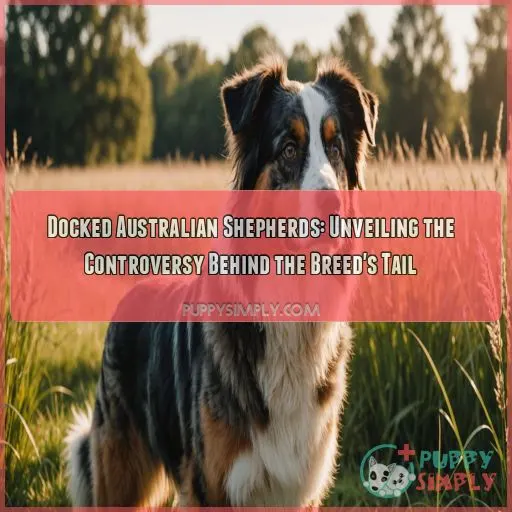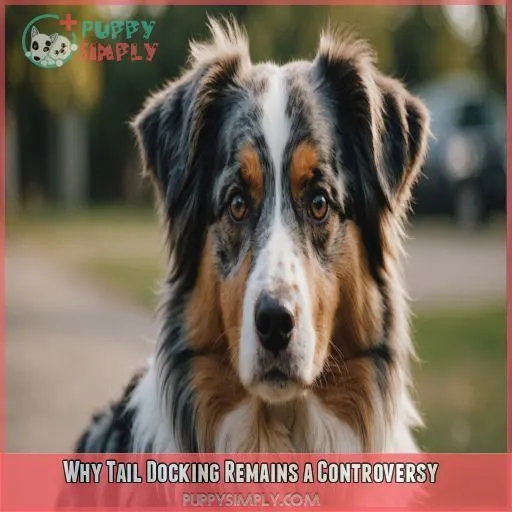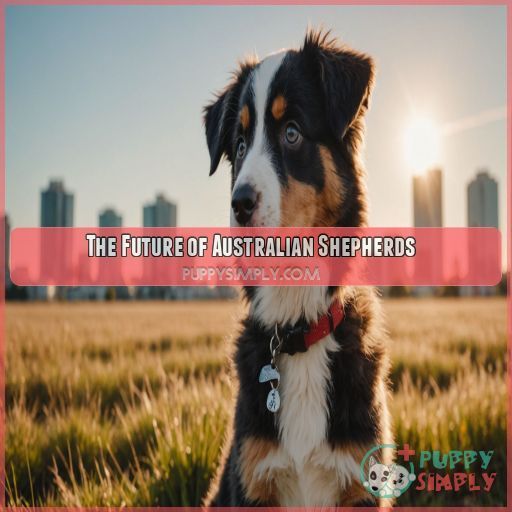This site is supported by our readers. We may earn a commission, at no cost to you, if you purchase through links.

Historically, tail docking was done to prevent injury during herding, but many countries have banned it for cosmetic purposes.
The natural bobtail trait is a defining characteristic of the breed, and responsible breeders prioritize genetic testing to identify carriers.
If you’re considering bringing a docked Aussie into your family, it’s important to work with a reputable breeder who prioritizes health and well-being.
Want to know more about the controversy surrounding Tail Docking and how to make informed decisions for your furry friend?
Table Of Contents
- Key Takeaways
- The History of Tail Docking
- The Natural Bobtail Trait
- The Debate Over Tail Docking
- Breed Standards and Judging
- Why Tail Docking Remains a Controversy
- The Role of Dewclaw Removal
- Owner Choice and Responsibility
- Tail Care and Health
- The Future of Australian Shepherds
- Frequently Asked Questions (FAQs)
- Why do they dock Australian Shepherds?
- At what age do Australian Shepherds get their tails docked?
- How do you tell the difference between a natural bobtail and a docked tail?
- Why do breeders dock tails?
- What are the reasons behind docking Australian Shepherd tails ?
- How does tail docking impact an Aussies balance and movement ?
- Do Australian Shepherds with docked tails experience emotional distress ?
- Can I find a reputable breeder who doesnt dock tails ?
- Are there long-term health risks associated with tail docking ?
- Conclusion
Key Takeaways
- The natural bobtail is a defining characteristic of Australian Shepherds, with tails varying in length due to genetics. It’s like a game of tail roulette – some Aussies hit the jackpot with tiny tails, while others end up with longer ones!
- Tail docking has deep historical roots, dating back to Ancient Rome. Who knew a short tail could be such a status symbol? It’s like the designer handbag of the canine world!
- The debate over tail docking is hotter than a summer barbecue. While some argue it prevents injuries in working dogs, others see it as an unnecessary cosmetic procedure. It’s a real tale of two cities!
- When it comes to your Aussie’s tail, you’re in the driver’s seat. Have a heart-to-heart with your vet, consider your pup’s lifestyle, and make an informed decision. After all, a happy dog is a wagging dog – no matter the tail length!
The History of Tail Docking
You’re probably wondering why some Australian Shepherds have docked tails, and the answer lies in the breed’s fascinating history. The practice of tail docking dates back centuries, with roots in ancient Rome and historical reasons that are still debated today (Source).
Ancient Roots of Tail Docking
You’d be surprised where tail docking originated – ancient Rome! They believed that short tails prevented rabies. Later, working dogs got exempted from taxes if they were docked. It became a status symbol, even fashionable! And, amazingly, some sheepdogs were docked just to pass off as working dogs. Who knew a short tail had so much history?
Historical Reasons for Tail Docking
- In ancient Rome, people believed that tail docking could prevent rabies.
- In the 1790s, working dogs were exempt from taxation if they’d docked tails.
- Tail docking became a fashion trend in the mid-1800s.
- Breed identification and standardization also played a role in the practice of docking.
The Role of Ranchers in Developing the Breed
As you explore the history of tail docking, you’ll discover that ranchers played a significant role in developing the Australian Shepherd breed. Their primary concern was breeding dogs with really good herding skills, which led to the selection of working dog traits, including the natural bobtail.
| Ranching Needs | Breed Development |
|---|---|
| Herding skills | Early selection of working traits |
| Working dog traits | Breeders focused on natural bobtails |
| Breed development | Ranchers prioritized functionality |
| Natural bobtail | Breed standardization followed |
Ranchers and breeders worked together to create a breed that excelled in herding, leading to the Australian Shepherd we see today.
The Natural Bobtail Trait
When you dive into Australian Shepherds, you’ll find that the natural bobtail trait is a defining feature of the breed, with tails varying in length and often sparking debate among breeders and owners. You’ll want to understand the importance of preserving the natural bobtail, a unique feature that sets Aussies apart, and how it relates to the breed’s history, identity, and the controversy surrounding tail docking (Source).
Defining Characteristic of Australian Shepherds
Imagine an iconic Australian Shepherd – agile, intelligent, and sporting a unique feature that sets them apart. You guessed it – their natural bobtail! This defining breed characteristic is a result of selective breeding for herding instinct and functionality. It’s an identifying trait that’s deeply ingrained in the breed standard, making Aussies instantly recognizable.
Varying Lengths of Tails in Aussies
You’re probably wondering why some Australian Shepherds have super short tails while others have longer ones. It’s all about genetics! The breed’s natural bobtail trait means their tails can vary in length. Some Aussies are born with tiny tails, while others have longer ones that might be docked to prevent injuries. Yep, it’s a thing!
Preserving the Natural Bobtail
You’re now familiar with the varying lengths of tails in Aussies, so let’s talk about keeping the natural bobtail around. As an Aussie enthusiast, you want to make sure this unique trait sticks around. Here are 4 ways to support keeping natural bobtails:
- Understand the breed standard: Recognize the importance of natural bobtails in the breed’s identity.
- Genetic testing: Responsible breeding practices involve genetic testing to identify natural bobtail carriers.
- Health concerns: Prioritize health over looks, and avoid breeding practices that compromise the dog’s well-being.
- Breeder responsibility: Choose breeders who prioritize preserving the natural bobtail trait.
The Debate Over Tail Docking
As you learn about Australian Shepherds, you’ll likely encounter the debate over tail docking, a practice that’s been a part of the breed’s history for centuries. You’ll discover the arguments for and against tail docking, and how breeders, owners, and veterinarians are working together to prioritize the health, well-being, and unique characteristics of this beloved breed (Source).
Concerns About Birth Defects
When you’re looking into Australian Shepherds, you might’ve heard concerns about birth defects related to tail docking. But what’s the real story? Let’s break it down.
| Concern | Description | Impact |
|---|---|---|
| Spina Bifida | A genetic condition affecting the spine | Increased risk with certain breeding practices |
| Skeletal Issues | Abnormalities in bone development | Potential long-term health problems |
| Nerve Damage | Injury to nerves during docking | Chronic pain or discomfort |
| Infection | Risk of infection after docking | Serious health consequences if left untreated |
Lack of Scientific Evidence
Tail docking. You’d think there would be a ton of scientific studies to back it up, right? But, it’s surprising how little concrete evidence there is. Here are 4 things to keep in mind:
- No genetic evidence supports the claim that tail docking prevents injuries.
- Many studies on tail docking are outdated or flawed.
- There’s limited research on the long-term effects of tail docking.
- Most vets agree that tail docking is a cosmetic procedure, not a medical necessity.
Successful Breeding Practices
When you’re looking into Australian Shepherds, you’ll find that responsible breeders have successfully bred natural bobtails for generations with minimal issues. By prioritizing genetic diversity, health testing, and ethical breeding practices, they’ve preserved the breed’s unique characteristic while promoting overall health and well-being. It’s a win-win for these amazing dogs and their owners!
Breed Standards and Judging
You’re about to dive into Australian Shepherd breed standards and judging, where the tail takes center stage. As you explore this topic, you’ll discover how the AKC breed standard, prioritization of breed type and natural bobtails, and specific judging criteria all play a big part in evaluating these amazing dogs.
The AKC Breed Standard
You’re wondering about the AKC breed standard for Australian Shepherds.
The AKC standard allows for both docked and naturally bobbed tails, as long as they don’t exceed four inches.
Yep, you read that right – four inches is the maximum length.
This standard prioritizes breed type, ensuring Aussies with docked tails or natural bobtails are judged on their overall structure and movement.
Prioritizing Breed Type and Natural Bobtails
You’re now familiar with the AKC breed standard, let’s talk about prioritizing breed type and natural bobtails. When evaluating Australian Shepherds, it’s important to look at their overall structure and movement, but also focus on breed type. Here are key points to keep in mind:
- Breed type should always be more important than personal preferences.
- Natural bobtails are a key part of the breed and should be kept.
- Tail length shouldn’t exceed four inches, whether naturally bobbed or docked.
- Judges should penalize dogs with tails exceeding four inches, with full tails receiving the most severe fault.
- Breeders should aim for a balance between breed type and tail length when making breeding decisions.
Judging Criteria for Australian Shepherds
When judging Australian Shepherds, you’re looking for a harmonious blend of structure, movement, coat, and temperament. Here’s a snapshot of the key criteria:
| Characteristics | ASCA Guidelines |
|---|---|
| Coat | Medium-length, straight or slightly wavy |
| Movement | Smooth, agile, and balanced |
| Temperament | Intelligent, active, and attentive |
| Structure & Conformation | Athletic build, docked tail, and piercing gaze |
As a judge, your goal is to find the perfect balance of these traits.
Why Tail Docking Remains a Controversy
When you get into Australian Shepherds, you’ll likely run into the debate about tail docking – a topic that’s caused a stir among breeders, owners, and animal welfare folks. You’ll hear arguments for and against tail docking, and see how this procedure has become a complicated issue that’s about more than just looks.
Arguments for and Against Tail Docking
You’re considering an Aussie, but you’re torn about tail docking. On one hand, some argue it prevents injuries in working dogs and looks neat. On the other hand, many believe it’s unnecessary, painful, and poses health risks. Aussie clubs and states have varying stances, too. Let’s weigh the ethical implications, working dog needs, and aesthetic preferences.
Cosmetic Procedure Vs. Functional Need
You’re wondering if tail docking is truly necessary or just a cosmetic procedure.
The answer lies in the breed’s original purpose: working dogs.
For Australian Shepherds, a shorter tail meant fewer injuries on the job.
But today, many argue it’s an unnecessary surgery.
Should you prioritize your Aussie’s looks or their natural functionality?
Ultimately, the choice is yours as their owner.
Pain, Discomfort, and Potential Risks
If you’re thinking about tail docking for your Aussie puppy, you’re probably worried about the pain and discomfort it could cause. And you’re right to be concerned! The procedure has risks like anesthesia, blood loss, and infection. Research suggests that docking can even lead to chronic muscle tension and long-term health problems for your dog.
The Role of Dewclaw Removal
You might be wondering, what’s the connection between dewclaw removal and tail docking in Australian Shepherds? As you explore the controversy behind the breed’s tail, you should think about the role of dewclaw removal in preventing injury and promoting the overall well-being of these amazing dogs.
Preventing Injury in Working Dogs
As you’re working with your Australian Shepherd, you want to make sure their safety on the job. Tail docking can prevent injuries from getting caught on burrs or stickers. Similarly, dewclaw removal can reduce the risk of injury in working dogs. Make informed decisions about these procedures with your veterinarian to keep your furry partner safe and healthy.
Useful Functionality of Dewclaws
You might be wondering, what’s the big deal about dewclaws? Well, these small claws can be super helpful for your Aussie, especially in icy conditions where they provide extra traction. They also aid in grip on varied terrain, help with climbing, and even come in handy for burrowing. Who knew those tiny claws were so mighty?
Owner Choice and Veterinary Guidance
As you weigh the pros and cons of dewclaw removal for your Australian Shepherd, remember that informed consent is key. Your veterinarian is there to guide you, not dictate what’s best. Consider your dog’s lifestyle, breed standards, and potential risks. Ultimately, it’s your choice. Make it an educated one, with your vet’s expert input, and prioritize your furry friend’s well-being.
Owner Choice and Responsibility
As an Aussie owner, you’re probably wondering what all the fuss is about with tail docking and dewclaw removal.
After all, you just want what’s best for your furry friend.
You’ll need to weigh the pros and cons, consider your dog’s lifestyle and needs, and have an open conversation with your vet to make informed decisions about their health and well-being.
Informed Decisions About Health and Well-being
As an Aussie owner, you want what’s best for your furry friend. When it comes to tail docking, making informed decisions about their health and well-being is key. Have an open chat with your vet, considering your dog’s lifestyle, breed standard, and potential risks. It’s all about finding the right balance between choice and responsibility.
- You love your Aussie for who they’re – tail and all!
- Think of the vet as your partner in decision-making
- A healthy pup is a happy pup – prioritize their well-being
- Don’t let others dictate what’s best for your dog – take control
- Communication is key – ask questions, share concerns
Governmental Intervention Vs. Owner Autonomy
Now that you’ve made an informed decision about your Aussie’s health, you might wonder if governmental intervention is necessary. While regulations aim to protect animal welfare, they can also limit your autonomy as an owner. Breed standards and ethical considerations should guide your choices, not strict laws. You need to find a balance between individual choice and responsible pet ownership.
Open Communication Between Owners and Veterinarians
Your Aussie’s tail is important, and talking to your vet about it’s key. This team effort helps you make smart decisions that keep your dog healthy and happy. You’ll both work together to figure out what’s best for your pup, whether it’s about breed standards, tail health, or if a docked tail is right for your Aussie.
- Your vet is your partner in keeping your Aussie’s tail healthy.
- Don’t be afraid to ask questions – your vet is there to help you understand.
- A good vet-owner relationship helps you make informed decisions without stress.
- By working together, you’ll make choices that match your values and put your dog’s well-being first.
Tail Care and Health
You’re an Aussie owner who’s curious about tail care and health for your docked Australian Shepherd – you’ve come to the right place. In this section, we’ll explore the essentials of preventing injuries and infections, understanding tail expressions and communication, and embracing the unique tale of Aussie tails, all while keeping your furry friend happy and healthy .
Preventing Injuries and Infections
| Prevention Tips | Why It Matters | Working Dog Needs |
|---|---|---|
| Check for burrs | Prevents painful removal | Regular checks |
| Trim hair | Reduces matting | Every 6-8 weeks |
| Clean regularly | Prevents infections | Daily cleaning |
| Avoid extreme temps | Prevents discomfort | Provide shade/shelter |
| Monitor for signs of injury | Prompt veterinary care | Know the signs |
Tail Expressions and Communication
You’re probably aware that your Aussie’s tail is an essential communication tool.
Pay attention to tail language, as it reveals their mood.
A wagging tail indicates happiness, while a tucked-in tail signals anxiety.
Watch for body cues like raised hackles or stiffening, as they complement the tail’s message.
Embracing the Unique Tale of Aussie Tails
Now that you know the importance of tail expressions and communication, let’s celebrate the unique tale of Aussie tails! From naturally bobbed to docked, every Aussie tail is special. By embracing their individuality, you’re promoting a healthy body image for your furry friend, but also recognizing the fascinating history and diversity of this beloved breed.
The Future of Australian Shepherds
As you consider bringing an Australian Shepherd into your family, you’re likely wondering about the breed’s distinctive tail – or lack thereof. While the debate over tail docking continues, one thing’s clear: responsible breeding practices and preserving the natural bobtail are key to this breed’s future.
Preserving Breed History and Heritage
You’re part of the Australian Shepherd community, and preserving the breed’s history and heritage is a collective responsibility. As you look to the future, remember that every decision you make about your Aussie’s tail has a ripple effect on the breed’s identity. Here are some key considerations:
- Learn about the breed’s origins and the role of ranchers in developing the natural bobtail trait.
- Understand the importance of breed standards in maintaining uniformity and promoting responsible breeding.
- Appreciate the value of the natural bobtail as a unique characteristic of the Australian Shepherd.
- Recognize the need for ethical tail docking practices that prioritize the dog’s welfare.
- Support breeders who prioritize preserving the breed’s history and heritage.
Commitment to Responsible Breeding Practices
As you consider bringing an Aussie into your life, remember that responsible breeding practices are key to ensuring the health and happiness of your new furry friend. Look for breeders who prioritize genetic health, ethical breeding, and puppy socialization. By supporting responsible breeding, you’re getting a healthier pup, but you’re also promoting a better future for the breed.
The Importance of Natural Bobtails in Aussie Identity
You’re now part of the Aussie community, where natural bobtails are a badge of honor. This unique trait is deeply rooted in the breed’s history and working ability. As a responsible breeder or owner, you have the power to preserve this identity. By choosing to prioritize natural bobtails, you’re helping to keep the Aussie spirit alive and thriving.
Frequently Asked Questions (FAQs)
Why do they dock Australian Shepherds?
You’re probably puzzled about why Aussies’ tails are docked. Practical purposes prevail: preventing painful tail injuries and infections, especially for working dogs, while preserving their iconic, naturally bobbed breed standard – safety and style in sync!
At what age do Australian Shepherds get their tails docked?
You’re wondering when Aussie puppies get their tails docked? Typically, it’s done within the first few days of life, before they’re even a week old, to minimize discomfort and help them heal quickly.
How do you tell the difference between a natural bobtail and a docked tail?
To tell the difference between a natural bobtail and a docked tail, you’ll want to check for a few things: a natural bobtail usually has a more rounded tip and a bit of fur at the end, whereas a docked tail often has a more abrupt cut.
Why do breeders dock tails?
You’ll find breeders dock tails for various reasons. It’s a blend of tradition, breed standards, and injury prevention. Some believe it enhances the dog’s appearance or performance. However, it’s a hot topic with arguments on both sides.
What are the reasons behind docking Australian Shepherd tails ?
You’ll find breeders docking Aussie tails for a mix of practical and traditional reasons. It’s said to prevent injuries in working dogs, maintain breed standards, and some folks just prefer the look. It’s a hot topic, though!
How does tail docking impact an Aussies balance and movement ?
You’ll notice your Aussie’s balance and movement aren’t much affected by tail docking. They’re agile and athletic, adapting quickly. However, their tail does play a role in communication and subtle body language cues. It’s a personal decision to think about.
Do Australian Shepherds with docked tails experience emotional distress ?
Ever wondered if your furry friend feels blue about their bobbed tail? You’ll be relieved to know that there’s no evidence suggesting emotional distress in docked Aussies. They’re typically happy-go-lucky pups, tail or no tail!
Can I find a reputable breeder who doesnt dock tails ?
Many reputable breeders now offer undocked Aussies. Do your homework online, check breed clubs, and ask around at dog shows. You’ll find a breeder who shares your values and has adorable pups with wagging tails!
Are there long-term health risks associated with tail docking ?
You might worry about long-term risks, but they’re generally minimal when done properly. Still, some vets suggest potential issues like chronic pain or altered balance. It’s best to weigh pros and cons with your vet before deciding.
Conclusion
Don’t worry about the controversy surrounding docked Australian Shepherds.
You can make informed decisions by understanding the breed’s history and natural bobtail trait.
Whether you choose a docked Aussie or one with a natural tail, what matters most is providing a loving home.
Embrace your furry friend’s unique tail, and you’ll have a loyal companion who’ll wag their way into your heart – no matter the length of their tail!















